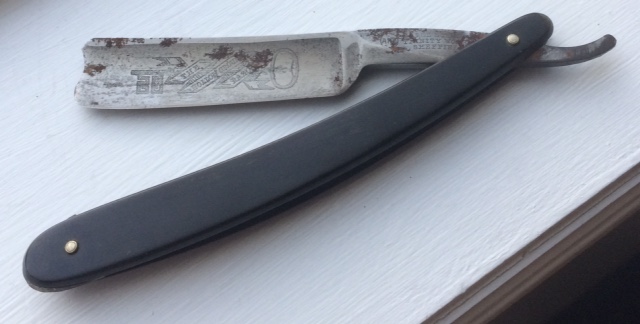Results 1 to 6 of 6
 36Likes
36Likes
Thread: How much shine is too much shine?
-
08-18-2017, 06:30 PM #1
 How much shine is too much shine?
How much shine is too much shine?
As I restore a vintage SR I have often wondered what the original finish of the blade was: high polish mirror shine or a matt finish...or somewhere in between. I suppose there is no way of knowing what the original really looked like in most cases, but I wonder how far should I go in trying to polish the blade. I must admit a high gloss mirror blade looks pretty neat, but was that the original state of the razor? What are your thought on this? I ask this question as I am about to restore a vintage George Butler Trinity works SR...pic below...

-
08-18-2017, 06:44 PM #2

I admit seeing the chromesk looking restores are always neat but I usually will only go to 2k wet dry and metal polish. I'm with you we will never truly know but seeing examples of super condition blades from old I guess we can get them only so close. Some I just do polish, kinda depends on what I want from the blade.
Seeing as that has an etch I use a hard backing and try to not sand a bunch in the blade face to preserve the etch.Nothing is fool proof, to a sufficiently talented fool...
-
08-18-2017, 06:59 PM #3At this point in time...




- Join Date
- Jun 2007
- Location
- North Idaho Redoubt
- Posts
- 27,068
- Blog Entries
- 1
Thanked: 13249
#1 Mirror finishes on restores are rarely actually mirror
#2 Looking at many many Vintage razors tells me Mirror finishes were pretty rare
#3 Polished out satin finishes tend to hide the old scars better on restores
But hey they are your razors so it is your choice
Personally, my goal is to make the finish look as good as possible to compliment the razor and that in my eyes is rarely mirror "No amount of money spent on a Stone can ever replace the value of the time it takes learning to use it properly"
"No amount of money spent on a Stone can ever replace the value of the time it takes learning to use it properly"
Very Respectfully - Glen
Proprietor - GemStar Custom Razors Honing/Restores/Regrinds Website
-
The Following 2 Users Say Thank You to gssixgun For This Useful Post:
JBHoren (08-21-2017), Voidmonster (08-18-2017)
-
08-18-2017, 07:05 PM #4

It varies a fair bit.
Many old Sheffield blades had two different surface treatments, one for the tang and tail and another for the blade. The most common there was full crocus (mirror, and a mirror with no visible striations -- it's hard-to-impossible to do with hand tools) with a glaze on the tang & tail. A glaze finish is roughly the same as 600-800 grit sandpaper.
Fancier razors were fully crocus polished.
Razors with blade etches were often crocus polished with the very notable exception of Wade & Butcher's 'Celebrated For Barber's Use' razors, which used a glaze finish on the entire blade and a dark etch (most older etches were done with an etchant that didn't darken the metal, but instead left microscopic pits that gave it a frosted look).
Very cheap & cheerful razors weren't polished at all and retain the original grinding marks, which are about the same as 100-300 grit sandpaper. I see those mostly from Sheffield razors made after 1890, but here and there I see earlier ones.-Zak Jarvis. Writer. Artist. Bon vivant.
-
The Following 4 Users Say Thank You to Voidmonster For This Useful Post:
Geezer (08-19-2017), JBHoren (08-21-2017), karlej (08-28-2017), ScoutHikerDad (08-20-2017)
-
08-18-2017, 07:47 PM #5

Actually, I'm gonna back that up slightly having had a look through what I've got, and agree with Glen that the crocus polish was a 'fancy' feature.
Here's some examples:

George Savage, 1870's, full glaze finish. There's some lengthwise sanding marks from me, but it was original finish when I got it. (And I didn't know better than to do lengthwise sanding when I got it.)

Abused and mysterious, Wolferman(?), 1810-1830. You can see the original crocus blade through the steel wool scratches of whoever dyed the scales black, and the original glaze on the tang.

Palmer (a London fancy goods and box maker, made by the Ragg family very early in their career), 1810-1815. Full original crocus. Hooray for display items in the family museum!

John & William Ragg, 1850's. Original crocus finish with frosted etch.-Zak Jarvis. Writer. Artist. Bon vivant.
-
-
08-18-2017, 08:40 PM #6

I think a well polished blade, you cannot beat. That said, if you dont have the tools or patience to polish the blade to a perfect mirror? Go with a more matte finish.
nothing looks better than a perfectly polished blade, but blades that are "polished" poorly just look tacky and cheap. one man's opinion though


 LinkBack URL
LinkBack URL About LinkBacks
About LinkBacks






 Reply With Quote
Reply With Quote

